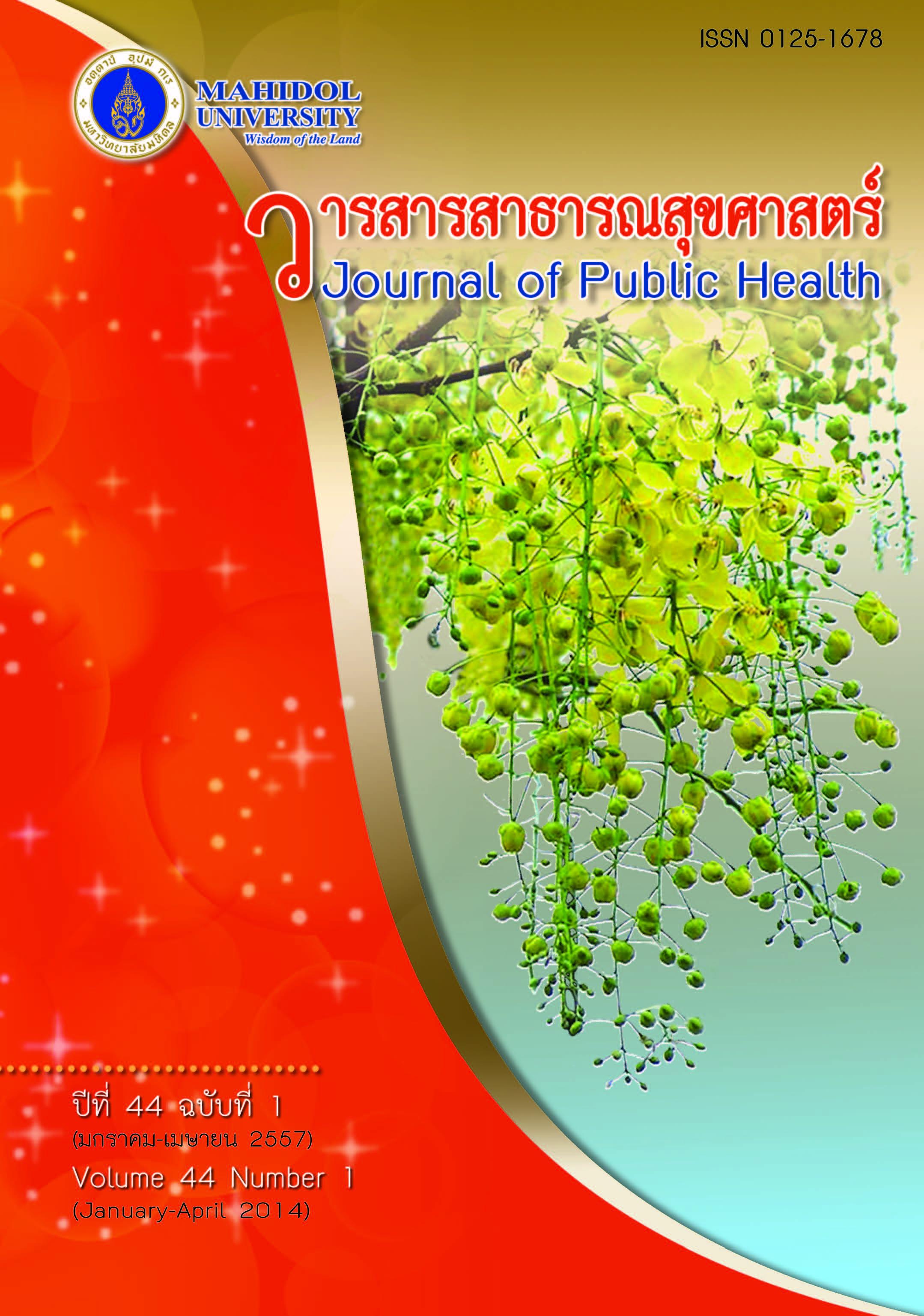ปัจจัยที่สัมพันธ์กับการใช้จักรยาน ของนักศึกษาหอพักภายในมหาวิทยาลัยธรรมศาสตร์ ศูนย์รังสิต
Keywords:
รูปแบบการเดินทาง, การใช้จักรยาน, นักศึกษา, Transportation organisation and administration, bicycling statistics and numerical data, university StudentsAbstract
บทคัดย่อ
มหาวิทยาลัยธรรมศาสตร์ ศูนย์รังสิต มีนักศึกษาภายในหอพักของมหาวิทยาลัย ประมาณ 8,600 คน การเดินทางภายในมหาวิทยาลัยของนักศึกษา มีรูปแบบหลากหลาย แต่ไม่เคยมีการศึกษาประเด็นนี้อย่างเป็นระบบ เพื่อใช้กำหนดนโยบายสาธารณสุข เรื่องการรณรงค์ใช้รถจักรยานภายในมหาวิทยาลัย ผู้วิจัยสุ่มตัวอย่างนักศึกษาหอพักภายในของมหาวิทยาลัย จำนวน 847 คน รวบรวมข้อมูลด้วยแบบสอบถามทางโทรศัพท์ พบรูปแบบการเดินทางสูงสุดสามอันดับแรกคือ รถรางสาธารณะ การเดิน และจักรยาน มีผู้ใช้จักรยานเป็นพาหนะหลักในการเดินทางร้อยละ 19 ส่วนผู้เคยใช้จักรยานเป็นพาหนะหลักแต่ปัจจุบันเลิกแล้วมีร้อยละ 27 อุปสรรคขัดขวางการใช้จักรยานคือ ความไม่สะดวก แสงแดด เครื่องแบบนักศึกษา และการโจรกรรมจักรยาน ตามลำดับ ปัจจัยที่มีความสัมพันธ์กับการใช้จักรยานคือ เพศชาย (p < 0.01) สถานะการเงินไม่สูง (p < 0.05) และการเป็นนักศึกษาของกลุ่มคณะสุขศาสตร์ (p < 0.05) งานวิจัยนี้ค้นพบกลุ่มคนที่ควรเป็นกลุ่มเป้าหมายรณรงค์ให้ใช้จักรยานคือ กลุ่มผู้เคยใช้จักรยานมาก่อน และกลุ่มผู้ใช้จักรยานยนต์เป็นหลัก นอกจากนี้การจัดระบบจักรยานสาธารณะ (Bike Sharing) การสร้างทางจักรยานในร่ม และการจัดระบบที่จอดจักรยานที่ปลอดภัย เป็นนโยบายที่อาจช่วยลดอุปสรรคในการใช้จักรยานในมหาวิทยาลัยธรรมศาสตร์ศูนย์รังสิต
Factors Associated with Bicycle Commuting in Thammasat University, Rangsit Campus
ABSTRACT
Thammasat University (TU), Rangsit campus comprises of several dormitories which accommodate almost 8,600 university students. Various modes of transportation in Rangsit campus such as public transportation, motorcycle, bicycle and walking, were found. However, no reliable data concerning mode of transportation, particularly bicycle commuting, in campus have been collected. The data could be applied to support campus’s public health policy of ‘bicycle campus’. A group of 847 Thammasat Rangsit dormitory students were randomly selected to be research participants. Data were collected by telephone interviewing. The result showed the three major modes of transportation were TU public free bus (also known as NGV bus or Engie), walking, and bicycling, respectively. Nineteen percent of the participants were cyclists, while 27% of the participants were ex-cyclists (students who had used bicycles for transportation, but do not anymore). The barriers for in-campus bicycle use were feeling of inconvenience, strong sunlight, student uniform, and bicycles were stolen. Students who are 1) male (p < 0.01), 2) in middle or lower economic status (p < 0.05), and 3) health science students (p <0.05), were more likely to be cyclists compared to other groups. This research suggested that we should focus on two groups, ex-cyclists and motorcycle users, as main target groups for the TU bicycle campaigning. Moreover, Thammasat University should reduce barriers of bicycle use by providing bicycle sharing scheme, campus-wide covered bicycle lanes and safe bicycle parking areas.
Downloads
Issue
Section
License
Creative Commons License CC-BY-ND


